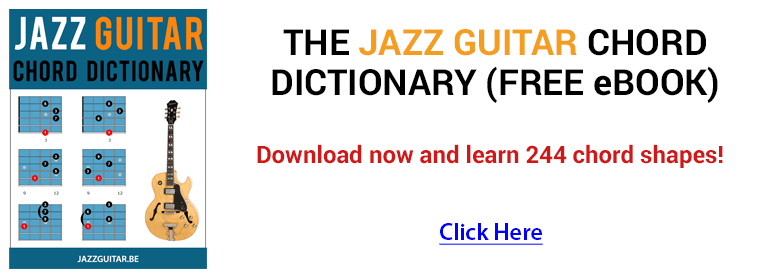-
Yeah, you can get away with a lot using arps only. Scales can require more knowing what you're doing or what's going on harmonically. Btw I like BH chord scale approach because it's a starting METHODOLOGY with rhythmic considerations etc, as opposed to merely a codex of "notes which aren't clams". Going to get the first DVD "for Christmas" next week. All you zealots have me curious. If anything, I love to hear the man talk. I need some old jazz guys to sit down with locally. Maybe some day... :-)
 Originally Posted by christianm77
Originally Posted by christianm77
-
01-02-2018 10:32 AM
-
The other thing, is if you use neighbour tones diatonically, you have to learn the scales anyway.
Take a C triad for instance - upper neighbour tones would be whole step above the 1 and 5, half step above the 3.
Add in a major seventh, and you have the whole major scale.
That can be a useful way to map the scales onto the guitar around chords.
-
Yeah but this is not purely a bebop thing. Mike Moreno plays lots and lots of straight scales for instance.
 Originally Posted by matt.guitarteacher
Originally Posted by matt.guitarteacher
-
I think that Sheryl Bailey’s family of four arpeggios is pretty much derived from the same arpeggios Barry Harris speaks of . It’s not just a Barry Harris scale, there are very specific arpeggios there, derived from each chord tone. (F7, A-7b5, C-7, EbM7)
-
Isn't that just a II V and the relative functional.... or diatonic functional subs
 Originally Posted by NSJ
Originally Posted by NSJ
C-7 and up a 3rd to Ebmaj7 (C-9)
F7 and up a diatonic 3rd to A-7b5... (F9)
Of which II V is a Common Chord pattern used in most Jazz tunes, and you can apply this same approach to all common jazz chord patterns used in jazz tunes, (or at least how jazz players play standards harmonically.
And then move on to extended Diatonic functional chords.
And then apply basically any organized application to the chord tones and have any number of organized functional methods of filling in notes.... Plug and play. Obviously some will work better than others, depending on what one is trying to accomplish with the application. Sound, vanilla, sound muddy, sound mechanical. sound blusey, sound hip etc...
That was how I used to arrange charts back before we just pushed keys and check it out approach being used now.
-
I was told off about that. Apparently the take away is that we can play any triad, arpeggio or chord from the scale.
 Originally Posted by NSJ
Originally Posted by NSJ
But 1 b3 5 b7 are the important chords IIRC, and they are 1 3 5 1, not sevenths.
There's some funky ones, particularly if you look at the tritone possibilities. F#maj7 - C on Dm7 G7 C anyone?
-
Of course it is. Barry Harris's harmonic options are probably largely similar to the ones you would play anyway. The main difference is the language that is used to talk about them.
 Originally Posted by Reg
Originally Posted by Reg
Upside - language is consistent, clear and assists the long term goals of his teaching
Downside - can be inaccessible to newcomers
BH Improvisation teaching is not IMO really about offering new harmonic possibilities (that's in the Harmony section). It's about creating lines and obviously, specifically bop lines. (Although some possibilities might be thought a little untidy in some circles - Bmaj7 on G7, for instance.)
I hear a lot of jazzers talking about harmonic possibilities, but not about how to construct lines. The latter is where BH may be of interest to students as the former is well understood.
(Although I think there are gaps in some players education's regarding diatonic scales and traditional note choices on dim7s and 7b9 chords for instance. I know I had them.)
Jazz improvisers sometimes talk about harmony and linear improvisation as if they are the same thing. There's some overlap, but all the harmony in the world won't help you come out with a good jazz line.... And a great line can often have very commonplace harmony.
It goes back to what Charles McPherson was talking about the, the what, the where and the when.
-
You mean Dominant?
 Originally Posted by NSJ
Originally Posted by NSJ
-
Yes sorry typo
 Originally Posted by Jonah
Originally Posted by Jonah
-
To be honest, I find studying BH ideas more simple and essential than a lot of other stuff. Even the half step fill in stuff is very flexible need not be applied rigidly. Because the most important thing of course is rhythm It gets you playing, even the 5432 stuff and Pasquale’s 4 note major minor sequences. Especially that stuff.
-
Me too
-
Well... lets hear some of the proof in the pudding.
-
Well I’ll tell you, this is what I’ve started to do is to record the first thing, when I get up, in the morning whatever comes out, just as a way of forcing myself to play, good or bad. That way there is no agenda, and I can see to whatever extent all the stuff I’ve been trying to internalize actually manifest itself without even thinking about it. Or it doesn’t. Obviously
 Originally Posted by Reg
Originally Posted by Reg
-
And all the other cats did not wake up yet?)))
 Originally Posted by NSJ
Originally Posted by NSJ
-
haaa, hey navdeep,
Love it... priceless vid. Not sure what of the connection between BH and playing through changes.... but I would watch another vid
Don't take everything i say that serious.... all I want is for guitarist to become better musicians... in any context.
Thanks Reg
-
FEED THE CATS! Then record.
 Originally Posted by NSJ
Originally Posted by NSJ
-
Scales and patterns are for practicing. Ears are for playing. It's like Lebron James practicing all his moves in the gym, but in the game, he has to go with the flow and react, not think. He might practice something in the gym that only appears in a game once a month, because the moment didn't call for it.
-
That's a fairly open statement... Ears that can't hear or haven't been exposed... or that only live in the moment... might not work that well.
 Originally Posted by paulcw16
Originally Posted by paulcw16
I'm not sure about the analogy.... and the facts.
Different approaches work for different people. But without really having a concept of where and what ones wants to go or do with their playing... the practicing and performance aspects, how to practice scales is basically meaningless.
-
To me the comment was an oversimplification especially the James analogy; he thinks and reacts. He is just able to do it quickly or what some call 'in the moment'. To me that is what 'practice makes perfect' means; increasing one's ability to think and react in the moment.
 Originally Posted by Reg
Originally Posted by Reg
-
I am of at least two minds about this stuff.
When I first picked up a guitar at age 13, all I wanted to do was to be able to accompany myself when I sang pop tunes.
My parents sent me to the local music store for lessons. This being NYC, the teachers there were all jazz guys.
My first teacher, Sid Margolis, started teaching - his way. Since I was 13 and didn't have any viewpoint about how to learn, I went along.
What Sid then did was to give me a foundation in music. His view, as I reconstruct it looking back, was that music is a body of knowledge and that his role was to impart it, with a focus on the jazz guitar.
So, I learned to read, I learned the chords big band players used, I learned chord melody, one tune at a time, and thereby built repertoire.
I now feel privileged that I had such a great teacher. I still use everything I learned from him and I'm now teaching pretty much his way.
So, how to practice scales? First, you need to have some idea of musical direction. But, what if you're a kid who knows a few songs he likes and not much more? What if it was your parents' idea that you should have music lessons to become a well-rounded individual?
My thinking is that a wise teacher will shoot for imparting a body of knowledge for a particular musical world. If it's going to be jazz, then teaching scales is a reasonable component. And, if you're going to play jazz and not scales, the thing to do, IMO, is teach pitch collections -- the notes of the scale but not in a specific order every time.
I'm still thinking about how exactly to present this material. My current idea is to start teaching improvisation with simple harmony and pitch collection. At the same time I'll continue teaching reading. Fretboard knowledge from reading, chops from reading and improv, ear training from transcription and formal exercises. Improv from improv, not from scales, meaning we start by improvising over Cmaj7 -- with the instruction to make melody, all over the neck, using C Ionian, then maybe C lydian (with full knowledge of which are the chord tones of Cmaj7 and which others make Cmaj13). Then add in G7/G13 (same notes as C Ionian, which isn't an issue because you were never practicing C Ionian from the root).
As the tunes get more complex, I'll introduce issues of how a chord can function harmonically in different ways.
-
Hey James... sure that is good example... but generally I'm usually implying that one needs to also be ahead, aware of what one does in the moment,(slow motion or longer moment), and how that effects the future... so when I react in that moment... I'm also aware of what that implies next, what that moment can create next time around or later in tune.
 Originally Posted by jameslovestal
Originally Posted by jameslovestal




 Reply With Quote
Reply With Quote



Moving from bedroom to stage...
Today, 08:38 AM in From The Bandstand